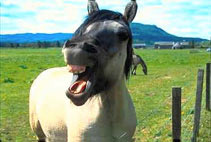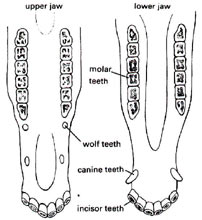When should equine dental care begin?
Foals should have their mouths examined soon after birth. This will allow for any problems, possibly congenital, to be dealt with and noted for future dental care. Proper handling and examination of the mouth will also prepare the young horse for routine dental maintenance. 
How often does my horse or pony need dental check-ups?
Routine dental care normally begins as a yearling with the removal of the wolf teeth and floating of the sharp edges.
After the initial visit by equine dental technicians, it is recommended that at least two visits per year be scheduled until five years of age when all the permanent teeth have erupted. After the age of five, the frequency of dental check-ups is determined on an individual basis. Two visits per year by dental technicians are recommended.
Do the incisors require regular dental maintenance?
In some cases, as a result of injury or abnormal occlusion and wear, the incisors may require treatment. The incisors should be examined as part of regular dental maintenance. What is a cap?
A cap is the remnant of a deciduous (baby) molar or incisor, which is shed at
specific intervals. During a regular dental maintenance, your equine dental
technician may remove the cap or caps, as necessary.

What is the function of the incisors?
The incisors allow the horse to obtain food
What is the function of the molars?
The molars masticate the food for digestion
What are wolf teeth?
Wolf teeth are vestigial teeth. They are normally noted to be forward of the first cheek tooth in the upper arcade or lingual (set to the inside of the first cheek tooth). They are easily palpated, and do not normally erupt. They may also occur in
t he upper and lower jaws.
Why are wolf teeth removed?
Many wolf teeth interfere with the function of the bit, and therefore should be removed as part of regular dental maintenance. This should be done at an early age to ensure clean extraction and avoidance of unnecessary behavioural problems associated with bitting pain. Why do the molars get sharp edges and require floating?
The upper jaw is normally wider than the lower jaw allowing for a somewhat
circular chewing motion, which involves a process known as lateral excursion. This motion allows for a grinding of feedstuffs, creating sharp edges on the outside (buccal) or check edge of the upper molars, and the inside edge of the lower molars. Many horses have sharp edges, which require floating of the whole tooth surface. It is recommended that the young horse's teeth be floated prior to bitting.
|